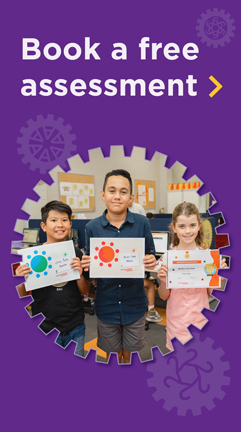Harnessing tech to improve your child’s lifelong learning

The way children learn in the classroom today presents an opportunity for a skilful blending of tech with traditional teaching methods. By harnessing features of online learning, students’ progress is easily tracked, feedback can be given instantly and teaching styles can be recorded, analysed and adapted further to suit the way their students learn. This approach has been perfected within NumberWorks’nWords centres and principles from this can be applied to children’s daily learning. Read on to learn how an encouraging environment using tech, is seeing students walk out of the centre feeling more motivated than ever.
Real-time Assessment
It starts with a comprehensive assessment that serves as a tool to identify the right entry point into the learning program for students, based on their gaps and strengths. This ensures students learn at the most effective level to establish a strong foundation of understanding before moving on to master the next concept. With the use of an onboarding app, students are then taken through a computer-based maths assessment and a blended English assessment - the traditional elements used to observe a child’s reading and comprehension ability. By undertaking this in real-time, parents can focus on their child’s key areas for improvement to avoid overwhelming them with big leaps of studying new material.
Realistic Goal-Setting
Students at NumberWorks’nWords are given regular opportunities to feel fulfilment from their effort. The key is to reward persistence rather than getting the correct answer on the first attempt. Being right is not always possible, but what students can develop is their level of grit and determination. These attributes can be applied to challenging situations throughout life, and present lasting rewards.
Progress through the Program
Students can gain a real sense of self-belief when they reflect back on how far they have come … and as the saying goes, we overestimate what we can achieve in one year but underestimate what can be achieved in 10 … or even three!
Taking time to celebrate students’ progress provides a benchmark for them to measure against and feel proud of how far they have come. Guiding students to achieve what is set as a goal for their study plan, keeps them focused on their journey rather than distracted by competing with others. This avoids limiting students’ progress according to their age group or set ability at that time. Students should feel that their own ability is limitless.
Instant Feedback
Feedback on work completed can be immediate, with programmed hints leading students to master a skill or concept before moving on to the next one. Tutors are then free to address more challenging concepts one-on-one with students at the point where they are not able to move ahead, or are wanting to learn and unpack the concept further. Not only does this approach promote mastery of a subject, it also keeps students more motivated and engaged in driving their own learning outcomes.
Gamification to build interest
The maths program has been crafted to include elements of gamification to excite students to want to build on their performance. The program is designed so that students know when they are getting faster and more accurate with their answers.
Success
The power of public recognition needn’t be underestimated. Shining a spotlight on students’ achievements is highly effective with a supportive audience. Consider how your child’s story may be shared to motivate others and to help make their progress tangible. A great way to do this creatively is to share their milestones within school newsletters, tutoring centre emails, or even sharing their journey with local media … not through a traditional write-up, but with blogs, online diary entries and visual progress graphs.
Want to find out how your child can experience the power of tech to enhance their English and maths learning, while building lifelong skills? Book a free assessment and introductory lesson with NumberWorks'nWords.



